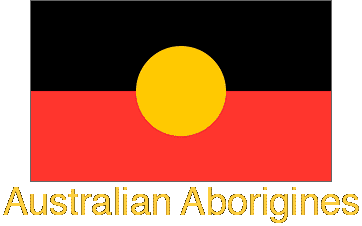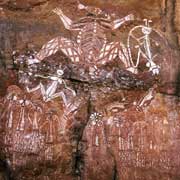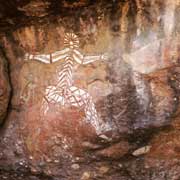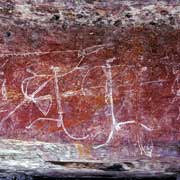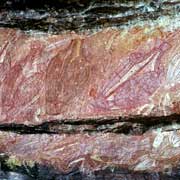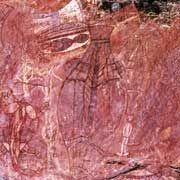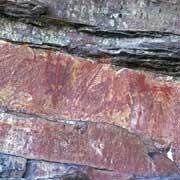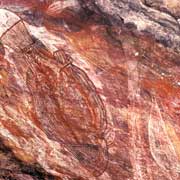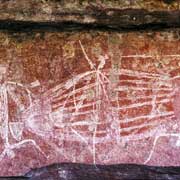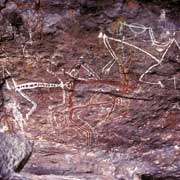Photos of Aboriginal Rock Art from Kakadu National Park, Australia
Aboriginal Rock Art from Kakadu National Park
The Aboriginal people of the Northern Territory have left a great legacy of their culture in the form of art that can be found in caves and rock overhangs where it is protected from the elements. One of the richest of these areas are at what is now Kakadu National Park, the traditional lands of the Gagudju people, in the Top End, just west of Arnhem Land.
you may then send it as a postcard if you wish.
There are many sites that are not open to visitors, like the cave with the Blue Paintings, of fairly recent origin and thus named because "Reckitts Blue", an agent to clean clothes, was used as well as traditional ochres; this site is now closed at the request of the traditional owners because there is a burial cave nearby. But there are superb examples of Rock Art in the galleries of Nourlangie Rock and Ubirr, where visitors can view them easily while the paintings are protected from vandals, sadly still a problem here as in other parts of the world.
"Nourlangie" is the anglicised name of the area traditionally known as Nawurlandja. The upper part and the lower areas of Nourlangie Rock are resp. known as Burrungguy and Anbangbang. According to the traditional Creation story, mythical short-eared rock wallaby creation ancestors travelled past Nourlangie Rock, across the Anbangbang billabong, and went up into the rocks at Nawurlandja. There they cut two crevices in the rock, still visible today. Rock wallabies can often be seen early morning and late afternoon. Burrungguy or Nourlangie Rock's main art site is the Anbangbang gallery, with beautiful examples, like the painting of Namondjok and Namarrgon, the Lightning Man.
Ubirr, or Obiri Rock, in the north east of Kakadu, has some of the finest examples of "X-ray art" in the world. The artist not only painted the outside but also the bones and internal organs of the animals, mostly fish like barramundi, but also turtles, birds and reptiles. Most of these paintings are less than 1500 years old. There is also a painting of a European, hands in his pockets. At the last section of the Ubirr gallery is a painting of the Rainbow Serpent on a cliff wall above what probably was an occupation site. This could go back in history as far as 23,000 years, although the Aborigines argue they and their ancestors have occupying the land forever.
Rock painting used to have several functions; images could have been made to increase the population of game animals or for use in magic. Dreaming beings have been painted as well, but also simple doodles. Nowadays Aboriginal people no longer make rock paintings: the last painting were done between 1962 and 1964 at the Anbangbang Art site. Aboriginal people no longer live in rock shelters and there are less and less people who have the knowledge to be allowed to paint at certain sites.
